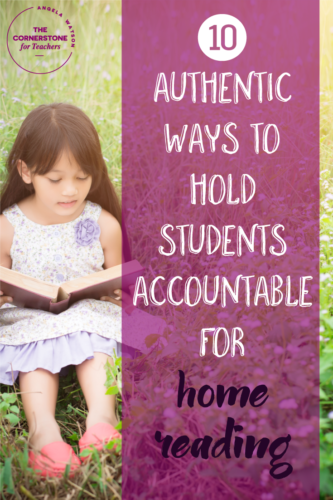Let’s face it: reading logs are boring, and most kids hate writing down the titles and authors of books they’ve read in order to “prove” they’ve done their required 20 minutes of reading time at home. Here are some more authentic ways to hold students accountable for their reading time and foster a love of books. Please note that SnapLearning is a supporter of The Cornerstone and the link to that site is sponsored.

1) Replace reading logs with book journals.
One year, I let students pick out a beautiful notebook to record their reading (they could bring in something they’d bought or choose from an assortment I’d gotten at the dollar store.) Having a special notebook they loved and felt proud of was much more motivating than scrawling book titles on a piece of paper or in a homework agenda book.
2) Show kids your own book journal and talk about why it’s useful to keep a reading record.
I let kids see that I write down the titles of everything I read and that I also jot down favorite quotes and passages. Then I ask why they think I take time to do that, and help them discover that it’s enjoyable to look back on what I’ve read over the years and remind myself of important take-aways and new ideas I’ve discovered.
3) Allow students to keep digital book journals.
My own journal is now kept in Notes and stored on iCloud so I can access it anywhere, so why not permit kids to do the same if they have access to a device? You can use apps that are specifically designed to record books or an all-purpose app like Evernote. This is an especially good option for kids who hate to write but love using the computer.
4) Encourage kids to record more than just titles and authors.
A list of books is far less interesting to write down (and read later) than reflections, inspiring or funny quotes, and so on. Though I have never mandated that students record “aha moments” during home reading, I always shared examples from my own reading and encouraged students to share theirs, too, as a model for the other kids (“I have to show you guys what Bryan wrote about this hilarious scene he read in his book this week—listen to this!”)
5) Ask questions about what students are reading.
Instead of (or in addition to) reading logs, talk with kids about their choices. Why did you choose that book? What’s your favorite part so far? Have you had any questions as you read? What new words have you noticed? How will you choose the next book you read? You can talk about these things in individual reading conferences (5 minutes per child per week or every other week during reading group rotations, for example) or at the beginning of your small group reading time as you talk about how students have applied strategies you’ve taught.
6) Provide access to a digital program that automatically tracks and creates reports on what kids have read.
For example, Snap Learning provides hundreds of grade-appropriate books, both fiction and non-fiction, which you can assign to your students and send to their devices (you can request a free demo to see how it works.) The reports created by these types of programs can be fascinating for kids: they love to see graphs of how much they’ve read!
7) If students read eBooks, have them take and annotate screenshots to reflect on their reading.
They can capture any part of the book that spoke to them and type out why they liked it or want to remember it. Remind students that this is for their personal benefit, not yours! At the end of the year, students can compile these screenshot images into a slideshow (simply by dragging the folder into Picasa or another free tool) and look back on all the best parts of their book choices.
8) Provide time for students to share their reading journals with their friends.
Once a month, I used a few minutes of our reading block for students to pair up and talk about what they recently enjoyed reading. This helped students get recommendations for new books to read, and gave them them extra motivation to find
9) Teach kids that it’s okay not to finish a book they don’t like and how they should record that information.
Students are forced to read enough texts in class—self-selected reading should be based entirely on what kids enjoy! Tell them about books you’ve picked up and just couldn’t get into, and permit them to do the same. Help kids use their reading journals to reflect on why a particular book wasn’t right for them (Too hard? Too easy? Didn’t like the author’s voice?) and use that as a springboard to look at aspects of strong writing. Encourage kids to use those less than enjoyable experiences with books to help them choose better books in the future. Set the expectation that reading time is precious and no one should waste it on a book that doesn’t speak to them.
10) Have kids revisit their reading journals later in the year and reflect on their growth.
Talk about how some of the books they selected in September were difficult for them, but much easier to tackle now. Invite them to talk about how their subject matter and genre preferences have evolved, and think about how they’d like to spend their reading time in the coming weeks.
How do you hold students accountable for their reading at home? Have you found any ways to make reading logs more meaningful? Share your ideas in the comments!
My Favorite Literacy Management & Teaching Ideas on Pinterest
Follow Angela Watson’s Teaching Ideas’s board Literacy Management and Ideas on Pinterest.

Angela Watson
Founder and Writer
Discussion
Leave a Reply
OR

Join our
community
of educators
If you are a teacher who is interested in contributing to the Truth for Teachers website, please click here for more information.
















At what age do you stop reading logs? My son is in 8th grade and they are expected to read 90 minutes during the week. With all the other subjects he’s reading for (Science, Social Studies, Etc.) he doesn’t have much time to get his fun reading in and he LOVES to read. This is my kid who read all the Harry Potter books in 2nd/3rd grade! And I agree with those that said, the reading logs turn kids OFF of reading. Half the time the parents “fudge” the reading anyway. I’m a first grade teacher and I TOTALLY get why reading at home is important. I guess I just get frustrated when we try to force (older) kids to read. You can only do so much to emphasize how important reading is! My older daughter hates to read–it happened in 5th grade. She wasn’t a strong reader and she had to turn in a book report a month. Well, she couldn’t keep up and got very frustrated and now HATES to read. She is a junior in high school and I think she has finally picked up a book she wanted to read on her own (Fault in our Stars). And she comes from a READING mom!! I understand there has to be an accountability piece with the younger students and they NEED the nightly practice. I tell my parents going over sight words can count as your 20 minutes. Again, love/hate relationship with reading logs from a parent perspective AND a first grade, reading specialist, teacher perspective!!
Great perspective, Kris, thanks for sharing. Can he count the reading he does for other classes in his reading log? I’m not sure I’ve heard of reading logs being required beyond elementary school.
I like the idea of using technology to motivate students about reading. I keep book lists on Goodreads.com and I show students how I keep a ‘read’ (with star ratings), ‘abandoned’ and ‘to-read’ list. I have them add those lists to their reading notebooks. If they are struggling to add books to the ‘to read’ list we circulate around the classroom and ask, “Read any good books lately?” Students refer to their ‘read’ list with star ratings when answering that question. When I ask kids, “What are you reading next?” and they are stuck I ask them to refer to their ‘to-read’ list. I also give them the option of completing reading logs and book reports at biblionasium.com. I also keep a spreadsheet with student names in the left vertical column and the date in the top horizontal column. Every few days (every day the first month) I publicly ask kids, “What are you reading?” and “What page are you on?” I give them permission to abandon books and prod them if they’ve only completed a few pages. Because this is a public conversation my fourth graders hear what their peers are doing and are often inspired. I also discovered it’s very common for a child to stop reading once they finish a book. They don’t know what to do next and need some prodding to select a new book. My goal is to develop a love of reading in my students and this helps.
Another option: use an app, like Books That Grow, that tracks how much your students have read: http://www.booksthatgrow.com.
Thanks for this inspiration. #2 really hit me – especially because I have been doing some topic specific historical fiction reading that I could easily share with my students. I’ll be doing a book report with my students right along side them now! I’ve linked up with you in my latest post: http://havingmycakeblog.blogspot.ca/2015/03/great-reads-to-keep-up-with-grade-3.html
Thanks again for the practical and interesting advice.
This is literally one of the best ides I’ve read on Pinterest in months!!!
So glad to hear that!